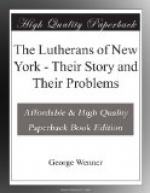Connecting links were two men whose names I have never seen associated with the story of the Lutherans of New York. One of them was Dr. Benjamin Kurtz of Hagerstown, the other was Frederick William III, King of Prussia. The king had imposed the Union upon the churches of Prussia and imprisoned the pastors who refused to conform. This was the king’s part in the movement. Dr. Kurtz had visited Berlin in 1826 in the interest of his educational schemes and in one of his addresses he implanted the microbe of America in the mind of a man who subsequently became a leader of one band of these pilgrims to the promised land. This was Dr. Kurtz’s share in the work. Both Kurtz and the king were unconscious instruments in the hands of Providence.
Dr. Kurtz was for a large part of the nineteenth century a distinguished leader in the General Synod. He contributed to the establishment of the Theological Seminary at Gettysburg and he was the founder of the Missionary Institute, now the Susquehanna University, at Selinsgrove. He died in 1865. His grave is in the campus of the University of which he was the founder.
But who were these immigrants and how did they come to be exiles? This is another story; but it has to be told, because in the providence of God it is connected with the history of the Lutherans in New York.
In the early years of the nineteenth century there occurred a remarkable religious awakening in Germany. This awakening had much to do with a revival of Lutheranism. It had been greatly strengthened at least by the publication of the Ninety-five Theses of Claus Harms in 1817, on the occasion of the tercentenary of the Reformation, and it in turn stimulated the Lutheran consciousness of multitudes who had been carried away by the rationalistic movement of the eighteenth century. The publication of the royal Liturgy in 1822 and the forcible measures of the king in ordering a union of the Lutheran and Reformed churches of the kingdom called forth the staunch opposition of the Lutherans. This ended in a widespread agitation which sent multitudes of families to a land where one of the chief fruits of the Lutheran Reformation, that of religious liberty, could be enjoyed.
The notable thing about the entrance of a few of these people into our New York life was that it injected new ideas into the stagnant mentality of the period. That the men who brought them were brusque and exclusive, was of small account. When Stohlmann, who had recently been called to St. Matthew’s Church, visited Pastor Oertel in his attic room, his Lutheranism, with a sly allusion perhaps to the stairs, was promptly challenged by the remark: “You climbed up some other way.”
Nor did it matter that on some points the new comers themselves were not agreed? The Prussians, later known as “Buffalonians,” led by Grabau, had a hierarchical theory of the ministerial office. The Saxons, later known as “Missourians,” led by Walther, had the congregational theory of church government. For a score of years a titanic conflict was waged between these two parties. It ended in a decisive victory for “Missouri.” Today “Buffalo” numbers 49 congregations, “Missouri” 3,689.




